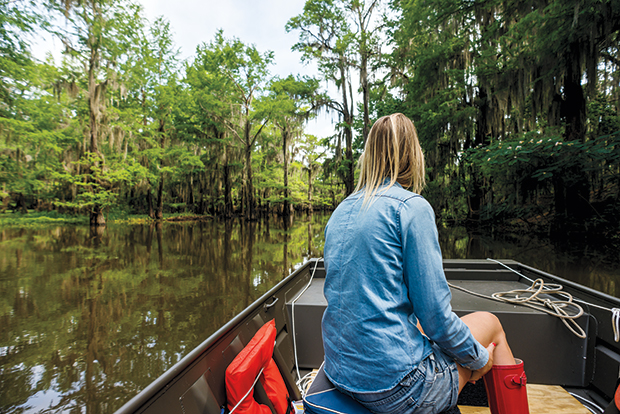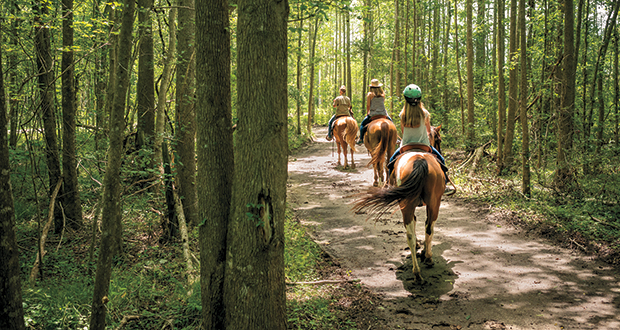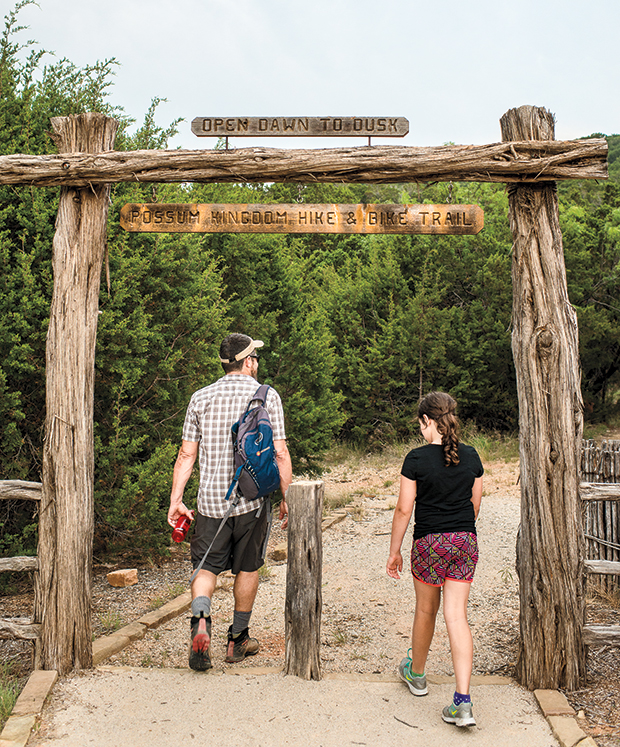
Bald cypress trees tower over the bayous, sloughs, and ponds of Caddo Lake.
Lakeside Lodging & Leisure
Caddo Lake State Park is at 245 Park Road 2, in Karnack. Entry fee is $4/day per person, kids 12 and younger free. Beyond cabins, screen shelters, RV pads, and campsites are available. Call 903-679-3351. For reservations, call 512-389-8900.
The Retreat at Artesian Lakes is at 235 Chain-O-Lakes Resort, in Cleveland. Recreational opportunities include swimming, canoe rentals, and fishing. Call 832-397-4000.
The Hide-Away Cabins and Inn is at 1782 FM 2951, in Graford. In addition to cabins, the property has a 16-room motel. Call 940-779-2333.
Caddo Outback Backwater Tours is at 1869 Pine Island Road, in Karnack. Call 903-789-3384.
WaterRush Rentals is at 3201 Redbird Road, in Graford. Based inside Lush Resorts, this recreational concessionaire can arrange cruises and water taxis, and rents stand-up paddleboards, Jetovator flying devices, pontoon boats, tubes, and kayaks. Call 940-463-5477.
Decades later, finding myself a father now living in another gigantic city, Houston, with opportunities to own a waterfront weekend cabin of my own out of reach, summer still brings a nostalgia for the panacea and sense of discovery I enjoyed in my youth. And with my 10-year-old daughter edging into the treacherous middle-school territory, with romantic confusion and hormonal rebellion to follow, time is running out to build the sort of rustic memories that should be every child’s birthright. So this spring, we set off on a tour of lakefront cabins spanning East Texas from Cleveland just north of Houston to Possum Kingdom Lake, a popular recreation area on the Brazos River, about a 90-minute drive west of Fort Worth.
The criteria for our selections, inspired by conversations with friends across town and colleagues across the state, my own travels through the years across Texas, and a bit of social-media sleuthing, were pretty simple: These cabin getaways needed to offer a slew of activities, including either swimming or boating; reasonable access to hiking trails or fishing; and enough fresh air, bright scenery, and potential solitude to counter the mental malaise that comes from stifling city heat and too much traffic. Hence in addition to Cleveland and PK, we appointed Caddo Lake to our list.
Caddo Lake State Park
For 16 years, John Winn has been leading his patented private swamp tours across Texas’ only naturally formed lake, Caddo Lake, which he describes as “really, a maze of lakes within lakes.” In his brand new broad-bottomed aluminum johnboat, Winn takes us past the boggy, cypress-strewn bayous of Hell’s Half Acre, down the Government Ditch, and through backwaters adjoining the Alligator Bayou and approaching the Devil’s Elbow, where the great lake starts its drift into Louisiana.
Our crew—including my wife, Christina; our daughter, Ursula; and Austin-based photographer Jenny Sathngam and a few of her friends—marvels at the scenery beneath the nearly cloudless sky. Between stands of tall trees strewn with Spanish moss, great white egrets and blue herons soar pterodactyl-like across the water’s surface. Winn explains that the area is home to 250 species of birds, and the lake forms the most diverse freshwater habitat for fish in Texas with 71 species. The water shimmers as a bass boat cruises by, and we pause next to a beaver lodge to see if anybody is home. Next our guide plunges us deeper into the primordial landscape.
“In a way, Caddo Lake raised me,” says Winn, a colorful storyteller who describes how a childhood of virtual neglect was reorganized once he was old enough to explore Caddo by himself, picking up secrets from old-timers who made their living off the lake.
Having spent his life on these waters, Winn shares history about the area as well, noting that Henry Ford used hanging moss from Louisiana and East Texas as stuffing for the seats on his early Model T, before customers complained that the cushioning contained too many hitchhikers—in the form of pesky insects. Caddo was also the site of one of the first offshore drilling rigs in the South, when in 1911 the predecessor of Gulf Oil—now part of Chevron—drilled into the Ferry Lake area on the Louisiana side. Our guide touches on the challenges of maintaining the natural splendor of the lake in this day and age. Exotic plant species have begun to choke out the natives, disrupting the natural habitat that benefits all the feathered and finned denizens that also make Caddo a destination for outdoor enthusiasts.
After the boat ride, we head to Caddo Lake State Park, where we have booked one of the historic cabins built by the Civilian Conservation Corps in the 1930s. The CCC was responsible for the construction of the entire 480-acre park, part of President Franklin Roosevelt’s efforts to reverse the impact of the Great Depression by offering jobs and training to unemployed young men across the state and nation. Constructed of thick cypress logs and locally sourced stones, the buildings have a timeless quality appropriate to the setting, with modest but comfortable décor that does not distract from the charms of the waterway. Visitors can choose small two-person cabins, four-person cabins, or larger, six-person cabins (as well as campsites). Ursula and I had enjoyed a previous stay at Caddo Lake, but this is Christina’s first trip.
Happily, the surroundings charm my wife as much as they had my daughter and I during our previous visit. As afternoon turns to evening, the three of us station ourselves on the porch to read and watch a house wren that had built its nest in a cranny beneath the roof. The cabin provides sturdy shelter as a storm blows through. Once the rain clears, we spark up the charcoal grill. Our marshmallow program soon draws the Austinites from their cabin across the way.
In the morning, we head for the fishing dock and try our luck with worms under bobbers. Ursula pulls in a long-eared sunfish, and Christina lands a whopper of a green sunfish, weighing nearly a pound, while I am left empty handed—until I remember that I have achieved my goal of memory making. For lunch, we stop off in the town of Uncertain at the Shady Glade Café, and after seeing the trophy largemouth-bass taxidermy decorating the walls, I am certain we will be back.
Beyond many miles of lake to explore, Uncertain warrants further consideration. Just 5 miles from the Louisiana border, tucked among the bald-cypress cathedrals of Northeast Texas, the village began as a steamboat landing. Today, fewer than 100 full-time residents call Uncertain home, though enviable second-home owners and weekend tourists temper the sense of isolation. Despite hard times, including major floods in 2015 and 2016 that forced evacuations, both Uncertain and nearby Karnack retain an authentic regional character hard to find in the city. I anticipate our next visit will furnish an opportunity for shopping at the Uncertain Flea Market, scheduled the first and third weekend of the month, as well as more fishing.
A guide leads a horseback trail ride through the wooded areas at the Retreat at Artesian Lakes.
Though we don’t enjoy a single gator sighting on Caddo Lake, where Winn admitted the big reptiles could be more easily seen at night, the wildlife on the outskirts of Cleveland—where the Smith family has run the Retreat at Artesian Lakes for 47 years—makes up for their absence. Formerly known as the Chain-O-Lakes, the Retreat comprises over 300 acres of linked lakes originally carved by sand and gravel extraction—some used for construction in Houston—not far from the Trinity River. Owner Jimmy Smith, a former dentist, has reshaped the spoil banks to create a decidedly low-key Disneyland-meets-Big Thicket-National-Preserve experience. “I’ve always been a bridge builder,” says Smith, making a dentistry pun. “The only difference is, since I quit my practice, the bridges have gotten a lot bigger.”
The Retreat boasts a variety of cabins suitable for romantic escapes as well as family reunions. Thanks to Smith’s ongoing landscaping efforts stringing together small islands and peninsulas, each one has a water view. The largest cabins have four bedrooms, and the resort also hosts guests at a few select private homes that are part of the Artesian Lakes development and available for rent.
Currently, corporations and professional groups dominate weekday business, while on the weekends the facility provides more traditional family fun with water slides, miles of hiking trails, and seasonal horseback rides.
The alligators fortunately don’t share the swimming facilities but rather reside in the main lake, which is fed by a series of natural artesian springs across the property that pump thousands of gallons of water into the lagoons each day. So we do not think twice about splashing in the spring-fed swimming hole, with me channeling my inner 12-year-old on the water slide. Despite my acrobatics, Ursula refuses to follow this daring lead. We shift focus to the scenic saltwater pool, which backs up to a manufactured boulder grotto that features a 12-person hot tub.
Meanwhile, spotting alligators and alligator snapping turtles, along with a few humongous grass carp, draws groups of diners to the deck of the Hilltop Restaurant. Part of the resort, the restaurant has an on-site herb garden and serves a fish buffet on Fridays, a Saturday breakfast buffet, and a popular Sunday brunch as well as weekend dinners and some holiday meals. Prominent signs remind people that across Texas it is illegal to harass, harm, or feed alligators (with the exception of hunting season, obviously), but diners can buy handfuls of fish food to toss to the turtles and fish from the restaurant patio. The largest of the local alligator snapping turtles reportedly weighs over 200 pounds and is likely a hundred years old.
Complementing this menagerie, as we travel back and forth to the cabin, we see several juvenile gators sunning themselves and also a few curious birds, including a green heron hunting the reeds for frogs or minnows. The next day, exploring a portion of the trails lined by pines and cypress with Smith, I halfway expected to run into Davy Crockett or one of his descendants. Certainly, with Smith’s son Wyatt now managing the resort while Jimmy focuses on building bridges, the Smith family legacy in East Texas will live on.

Hikers can enjoy a scenic lookout on the Riverbend Corner trail in Possum Kingdom State Park.
On a cabin cruiser he once captained through the Caribbean, Bo Bennett happily steers us on a sunset tour of the Possum Kingdom Lake’s 100-foot-tall Hell’s Gate formation, where the Red Bull Cliff Diving World Series this year returns with international daredevils competing over Labor Day weekend. As one of Bennett’s friends appears unexpectedly on the rocks of nearby Devil’s Island, we expect we might enjoy a preview, but the man remains intent on letting his feet rather than gravity return him to the surface of the lake, where a boat waits for him. With gentle waves lapping our hull, we drift away from the sunset that illuminates the cliffs, casting them in copper. We reach the dock as the first stars appear in the night sky.
“Really, we always say the best way to see Possum Kingdom is from the water,” grins Bennett, who owns Lush Resort with his wife, Gelasia. The scenery leaves zero room for debate. I had been directed to Lush for recreation by my hosts at the nearby Hide-Away Cabins and Inn, a popular downhome lodge overlooking the lake.
The Hide-Away has 20 basic cabins, all of which have been built and remodeled by the current ownership, but you need to have the wherewithal to make your own fun or hire a friendly local. Our cabin sits high on the crest of a hill with a partial view of the aquamarine depths of the lake below. A quarter-mile away, we can access the 16-mile hike-and-bike trail network that basically parallels Farm-to-Market 2951.
During Texas’ frontier days, the landscape hidden below the majestic lake’s surface was known for its fur-trapping industry (especially for its possum pelts, offering one explanation for the name). Surrounded by dusky, salmon-dusted limestone bluffs, the 17,000-acre lake did not exist before 1941. That year the Morris Sheppard Dam captured the running waters of the upper Brazos River, the first of three flood-control projects that aimed to tame the stream.
A half dozen years since the wildfires of 2011 devastated the area, summertime fun seekers have returned to PK—as it’s called—in full force. We quickly grasp why generations of Texans consider the crystalline blue-green waters of the reservoir—with more than 215 miles of shoreline—a perfect getaway. Wet and wild activities range from wake surfing and cliff diving to SCUBA diving and stand-up paddleboarding, while public parks and boat ramps run by Texas Parks and Wildlife, as well as the Brazos River Authority, offer recreational access.
In the morning at Sandy Beach off FM 2951—one of the public picnic and camping areas at the west end of the PK peninsula—Lush Retreats’ “ambassador of fun” Jesse Swanson, who runs the resort-affiliated WaterRush Watercraft Rentals and Jetovator, brings us a pair of stand-up paddleboards. Ursula finds her sea legs in no time and cruises the shoreline by herself. Although when a big wind comes up and blows her into deeper water, she needs me by her side to show her how to turn in the choppy waves. Back on dry land, we watch the scissortailed flycatchers do their mating dance until Ursula is ready to pick up her paddle and get back on the board again.
Though we also could have gone back and used the cabin kitchen, with my wife staying behind to work, the tween and I opt for a meal of fresh fried fish at Boondocks, a watering hole that on a quiet weeknight does not object to a 10-year-old patron.
Even though each of these Lone Star destinations bear little resemblance to the hills of Duchess County where I played as a kid, the cabins offered my family the same simple, restorative experience I recall from those weekends at the pond. In turn, I make a mental note to add paddle boarding to my list of aquatic activities despite minor reservations about trying it in gator country. Nonetheless, Texas has dozens of large lakes I have yet to visit, and we only sampled a handful of cabins. At last, it occurs to me that a cabin by the lake can be more than housing; it can also be a state of mind.








